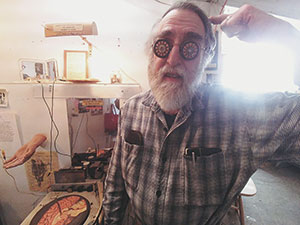
*
Robert Goss met me in the lobby of the Bakery Building at Brickbottom Artists in Somerville, MA. Brickbottom is a noted artist residence and exhibition space that is celebrating their 30th anniversary in 2018.
Goss, is a 70ish man, with a full gray/white beard and a genial, folksy manner. He led me to his space, that on first impression looked a bit like a junkyard – but on closer inspection these throw away objects have come together to form Goss’s art, and make a statement about his life. I walked around the space and saw disembodied plastic hands sprouting unexpectedly from the walls, and contraptions like a record player, with a picture of a brain rotating on the turntable. There were old medical records on display, news clippings, heads of dummies staring at me with piercing eyes – all detritus that is essential to Goss’s work. He walked around the space like some scholarly docent stooping and squinting at his creations.

Robert Goss
Goss is not some isolated bohemian eccentric, but a founding member of the Brickbottom Artist Building. He is an accomplished artist who has exhibited locally and nationally. He is the co-director of the Invisible Cities Group that creates large outdoor installations and performances.
Years ago, Goss was living in the Fort Point Channel section of Boston – now a high end ‘hood with the likes of Amazon and General Electric vying for space. In the 70s and 80s Goss was paying three dollars a foot for his space, but he and others in his community saw the writing on the wall – they knew they would be eventually displaced. So he and his band of artists, with the use of posters, regular mail, word of mouth, made a great grassroots effort to bring Brickbottom to fruition. The building – in the hinterlands – just outside Union Square was a defunct A&P food plant and a cold storage warehouse. There were a total of three buildings. After getting together a rather large group, this ragtag army of artists and others managed to raise seven million dollars from banks, donations, and the help of the Fort Point Artist community. Goss told me that the place did not look like some sleek Tribeca building. He said, “It was a mess. Outside the building was a burnt out car, and a lot of discarded bric-a-brac. He, Lisa Bouchard (the office manager), and others worked out of a trailer.
Goss, who lives with his wife Susan Schmidt, an accomplished artist who teaches at Holly Cross, told me that the late Jack McLaughlin, the construction manager, was an essential person, liaison, in the nascent process. Goss said, “He was able to deal with the mercurial artist and the bottom line real estate broker, equally well.”
Live-work units in the building were determined by a lottery, and of course people had to submit slides and a resume to show that they were serious artists. Predominantly comprised of visual artists at first, the gallery now houses theater people and writers.
Goss’s archival process is in the infant stages. But he hopes to have the original founding members of the building tell their stories. Like his collection in his space, he hopes to collect stories, photos and anecdotes, that will create a compelling narrative of this institution.
The list of artists who have lived here, and presently live here, is impressive. Goss just listed a few prominent folks like Susan Schmidt, Pier Gustasson, Chris Enos (photography), but this is only a grain of sand in the Sahara.
Goss has his own compelling story. He told me that he suffered a traumatic brain injury. As a result of this he suffered from a condition called Anhedonia. This condition manifests itself with the loss of pleasure with things that usually brings you pleasure. In the case of Goss, it was jazz. Goss was steeped in the jazz tradition and witnessed the “Loft” and club scene in New York in the 60s and 70s. He told me he saw Thelonius Monk play as well as Mile Davis and others. During his rehab he went through an MRI. Goss said the rhythmic knocking, tapping, while he was in the machine, might have jump-started his brain. He remembers hearing a song by King Pleasure on the radio. And suddenly everything came back to him.
Goss is not a pretentious man. He works at his art out of his own passion and interest, and if it communicates something to people then all the better. He alters photo images, he combines text, he brings back the archaic, and makes it contemporary. He says his art tells the story of his life. And hopefully his band of brothers and sisters will tell the fascinating 30-year history of Brickbottom Artist Building.















Reader Comments